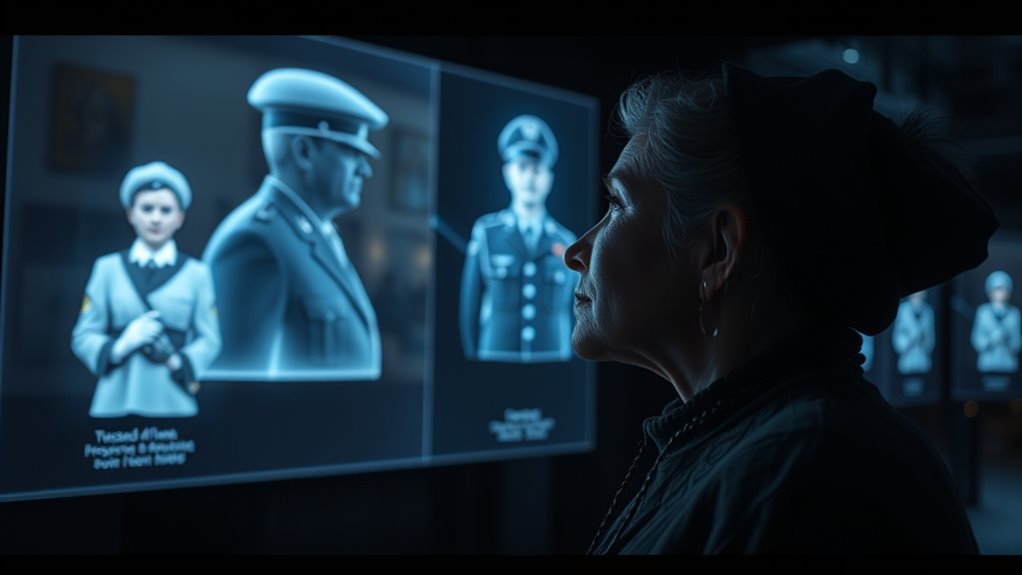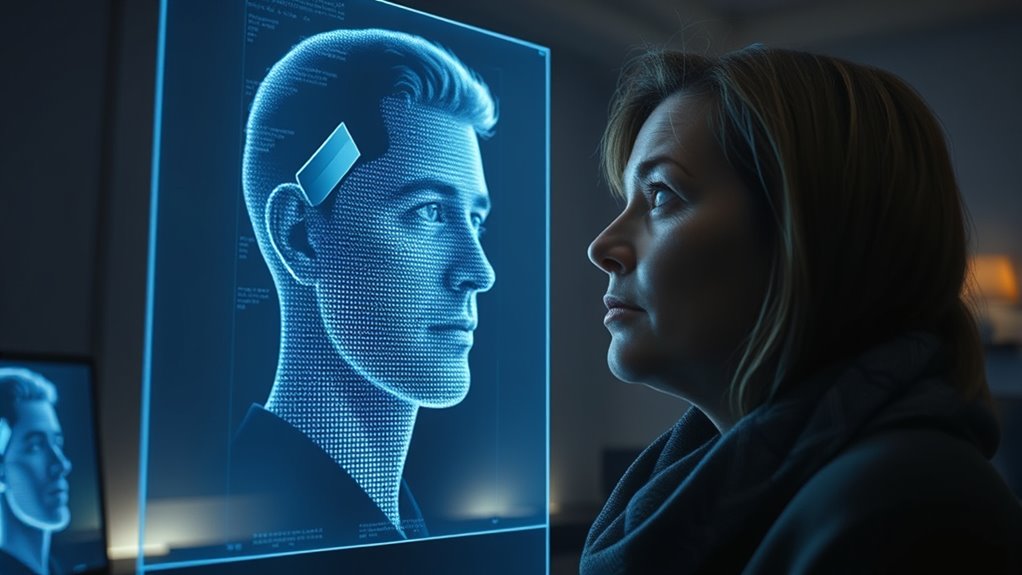AI technology now allows families of fallen soldiers, including Russian widows, to give their loved ones a digital farewell. By creating realistic avatars that preserve memories and personality traits, these tools offer comfort and a sense of ongoing connection. Some see it as a meaningful tribute, while others have concerns about authenticity and emotional reliance. To discover how this innovation impacts grief and remembrance, explore the full story.
Key Takeaways
- AI technologies create digital avatars of fallen soldiers for virtual farewell ceremonies and memorials.
- Russian widows use AI-generated videos and chatbots to reconnect and say goodbye to their lost loved ones.
- Digital resurrection offers emotional comfort and a sense of closure for grieving families of soldiers.
- Ethical concerns arise over consent, authenticity, and potential emotional dependence on AI representations.
- The trend reflects broader societal acceptance of AI remembrance, particularly in cultures with strong memorial traditions.

This digital resurrection impacts families emotionally and socially. Widows, children, and communities find comfort in these interactions, feeling a renewed sense of connection and closure. They can share untold stories and memories that might otherwise be lost, preserving a piece of their loved ones’ identities. Although responses are generated by algorithms, they often feel personal and authentic, which can be both comforting and uncanny. However, reactions vary widely; some families embrace this technology as a tribute, while others feel uneasy with artificial continuations of the deceased. Ethical concerns surface around consent, authenticity, and the potential for renewed grief if expectations aren’t managed carefully. The accuracy of AI avatars** depends heavily on the quality and quantity of input data, which remains a technical challenge. Culturally, AI resurrection gains popularity across different regions. In China, “AI resurrection” videos trend on social media, while in India, memorial WhatsApp groups keep the digital presence of the deceased alive socially. Western startups develop personalized AI afterlife experiences, often incorporating VR and AR for immersive remembrance. Attitudes toward these technologies differ based on cultural, religious, and societal views on death and digital identity, with some East Asian cultures more readily integrating AI ancestors into rituals. Despite its promise, AI resurrection faces technical challenges. The quality of avatars depends on ample, high-quality data; insufficient input results in less realistic interactions. AI cannot fully replicate spontaneous human emotions or consciousness, and risks such as deception or exploitation remain. Maintaining these digital personas requires ongoing resources and updates. As the technology advances, the societal impact of digital immortality** will continue to grow, reshaping how we grieve, remember, and honor those who have passed.
Frequently Asked Questions
How Does AI Ensure the Emotional Authenticity of Digital Recreations?
AI guarantees emotional authenticity by dynamically adjusting responses based on real-time cues like micro-expressions and voice tone, making interactions feel more natural. It uses sophisticated algorithms trained on storytelling principles to evoke genuine emotions such as grief or nostalgia. By customizing responses and employing narrative techniques, AI enhances emotional resonance, though it remains aware that true authenticity is limited. This creates a more meaningful experience, even if genuine emotion isn’t present.
What Are the Ethical Concerns Surrounding Resurrecting Deceased Soldiers?
You should consider the critical concerns about resurrecting deceased soldiers. Ethical issues arise around unauthorized use of likenesses, risking respect and reputation. You might unintentionally prolong pain by preventing natural grieving or distort memories through inaccurate representations. Profit motives can commodify the dead, while cultural and emotional sensitivities demand dignity and discretion. Balancing technological potential with moral responsibility is essential to guarantee respectful, honest, and humane handling of fallen soldiers’ digital personas.
Can These AI Recreations Be Personalized by Families?
Yes, you can personalize AI recreations of lost soldiers by providing photos, videos, or voice recordings, which help make the digital memorial more authentic. Families often submit personal data through social media or dedicated platforms, allowing AI to mimic facial features, expressions, and speech. Your contributions help create a more meaningful farewell, but privacy restrictions and technological limitations may affect how much customization is possible.
How Long Does It Take to Develop a Digital Soldier?
Developing a digital soldier typically takes several years, often between 2 to 5 years for prototypes to reach limited operational use. The process involves stages like AI model development, sensor integration, and rigorous testing, which can extend timelines, especially for full capabilities. If you’re working on such projects, expect complex coordination across multiple domains, with international efforts helping to accelerate development through shared standards and resources.
What Are the Privacy Implications for Families Involved?
You might think you’re safe, but privacy implications are lurking behind every digital farewell. Families involved face a rollercoaster of emotions—closure, vulnerability, and the risk of exposure. Your loved ones’ faces, once public, could be used without consent, raising fears of surveillance or legal repercussions. The line between honoring memories and protecting privacy blurs, leaving you questioning how much control remains in this digital age.
Conclusion
You might find it astonishing that over 80% of Russian widows felt more at peace after saying goodbye to their loved ones through AI-generated images and videos. This technology offers a digital farewell, helping you process grief and find closure. While it can’t replace real moments, it shows how innovation can bridge the gap between loss and remembrance, providing comfort in times of unimaginable pain.









